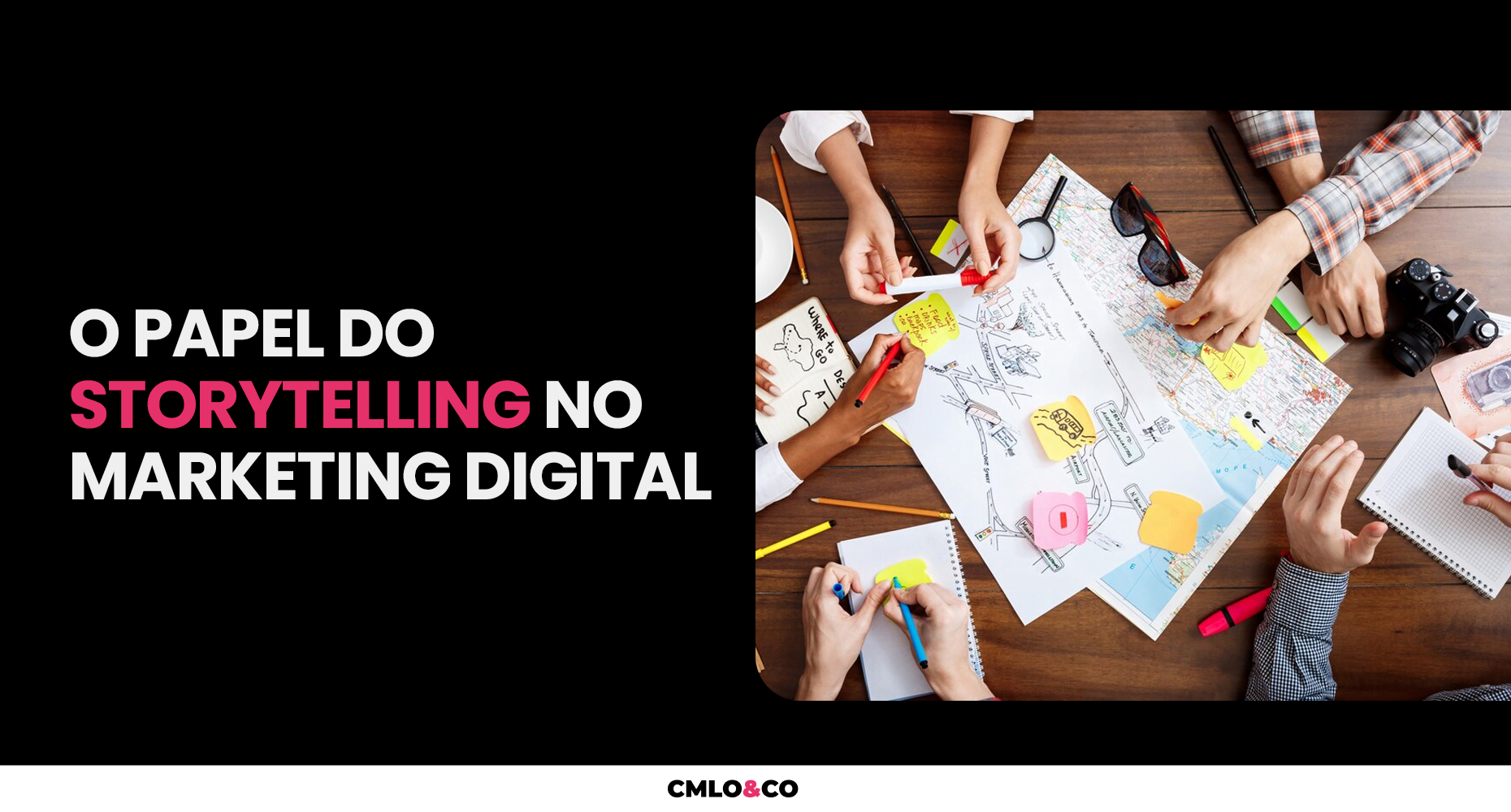Storytelling is a powerful tool that has been used for centuries to convey messages, values and cultures. In the context of digital marketing, this concept has become essential for creating emotional connections with the target audience and differentiating brands in an increasingly competitive market.

But what exactly is the role of storytelling in digital marketing and how can this strategy capture the imagination and engage audiences? If you share this same doubt, don't miss the opportunity to read this article to the end. In it, we'll explain how to incorporate the art of storytelling into your company's marketing and how this decision can boost your business. Check it out!
What is storytelling?
Storytelling is the art of telling stories in an engaging and persuasive way to convey a message or idea.
In digital marketing, this technique is used to create a narrative that resonates with the public, humanizes the brand and inspires action. Through a good story, companies can capture consumers' attention, generate engagement, build lasting relationships and make their brands memorable.
How does storytelling work in digital marketing?
The storytelling strategy is not just about telling any story, but about creating a narrative that is engaging, relevant and aligned with the brand's objectives. In digital marketing, this can be done through various digital platforms, such as blogs, social networksemails and videos, for example.
In order to develop an effective strategy, it is essential to consider various elements and stages that guarantee the creation of an impactful and persuasive story. Below, we detail each of these elements and how they work in practice.
Key elements of storytelling
Characters
Characters are fundamental to any story, as they are the ones who will represent the brand and connect emotionally with the public. That's why it's important to create characters that are relatable and that reflect the company's target audience. This helps to create empathy and identification, making the story more engaging.
Dove, in its "Real Beauty", used real women as characters to represent diversity and authentic beauty, creating an emotional connection with its audience.
Storyline
The plot is the development of the story, where the challenges, conflicts and journey of the characters are presented. In this sense, you should create a captivating narrative with a well-structured beginning, middle and end, keeping the audience engaged and interested in knowing the outcome of the story.
Old Spice's "The Man Your Man Could Smell Like" campaign is a good example of a fun and unexpected storyline, showing the character's transformation in a creative and engaging way.
Conflict and resolution
It's also worth pointing out that all good storytelling needs a central conflict that challenges the characters and creates tension in the story.
It is through this conflict that the brand can highlight its products or services as the solution to the problem presented, culminating in the resolution of the conflict.
Emotion
Emotion is one of the most powerful elements of storytelling in digital marketing, as it creates a deep emotional connection with the audience. Using emotions such as inspiration, joy, empathy or even sadness can help to engage and touch the hearts of consumers, making the story memorable.
Want a good example? Always' "Like a Girl" campaign used emotion to challenge gender stereotypes and empower girls and women, creating a significant impact and sparking conversations around the world. Hit play below and watch the 2015 Emmy-winning commercial:
Structure of a good story
To ensure a cohesive and engaging narrative, it is important to follow a basic storytelling structure, which includes:
- Introduction: presentation of the context, characters and setting of the story;
- Conflict: the introduction of a challenge or problem that the characters have to face;
- Climax: the point of greatest tension and turning point in the story, where the conflict reaches its climax;
- Resolution: how the conflict is resolved and the characters overcome their challenges;
- Conclusion: lessons learned, character transformations and call-to-action for the public.
Advanced storytelling techniques
In addition to the basic elements and structure of the story, there are some advanced techniques that can be used to improve the strategy:
- Non-linear narrative: a plot that doesn't necessarily follow a chronological order, but uses flashbacks, foreshadowing and changes of perspective to create a more complex and engaging story.
- Nested loops or interconnected stories: creates a series of stories related to the main one, which complement each other and strengthen the brand message over time.
- In Media Res (in the middle of things): as the name suggests, this is a type of plot that starts in the middle of the story, i.e. at the height of the action, and then goes back to explain what gave rise to that point.
In addition to these techniques, there are several others that can be exploited to tell the story of a brand or product in a creative and engaging way. For all of them, the combination of text, images.., videos and audio can enrich the narrative and make it more impactful and memorable.
Types of storytelling to enrich your digital marketing
Storytelling in digital marketing can be applied in different ways, each with the aim of reaching different audiences and conveying different messages.
Knowing the different types available therefore allows companies to choose the most appropriate approach for their specific needs and objectives. See below:
Brand storytelling
Also called brand storytellingfocuses on telling the company's story, highlighting its values, mission, vision and history.
The aim is to humanize the brand and create an emotional connection with the public, showing the purpose behind the business and the positive impact the company wants to have on the world.
Product storytelling
The product story focuses on presenting an item or service in an engaging way, highlighting its benefits, functionalities and how it can solve problems or meet consumer needs.
In this case, the aim is to persuade the target audience to buy the product or service by showing its value and differential on the market.
Customer storytelling
Customer storytelling focuses on sharing real stories of customers who have had positive experiences with the brand, highlighting their testimonials, feedback and how the product or service has positively impacted their lives.
The aim is to build trust, credibility and show potential customers how the brand can meet their needs and expectations.
Visual storytelling
Visual storytelling uses visual elements such as films, series, photos, videos, infographics and animations to tell a story in an impactful and engaging way. The combination of images, colors, movement and music can create an immersive and memorable experience for the audience.
Digital storytelling
Digital storytelling uses digital platforms and channels, such as social networks, blogs and podcaststo share stories in an interactive and engaging way. Through relevant, creative and personalized content, brands can reach and engage their target audience in an effective and targeted way.
Storytelling in digital marketing: benefits for business
Storytelling is a powerful strategy in digital marketing that offers a number of significant benefits for businesses:
Create emotional connections with the public
One of the main benefits of storytelling in digital marketing is the ability to create deep emotional connections with the public.
After all, stories have the power to touch people's hearts, evoke emotions and generate empathy, which can lead to greater brand identification and loyalty.
Differentiates the brand in the market
In a saturated and competitive market, it is essential for brands to find ways to stand out and differentiate themselves from the competition.
Storytelling allows companies to share their unique stories, values, mission and vision, helping to build a strong and memorable brand identity.
Increases engagement and interactivity
Engaging, well-told stories have the power to capture the audience's attention and keep them engaged for longer.
And the most interesting thing is that the strategy can be used in various formats and channels, such as videos, blogs, social networks and podcasts, providing an interactive and immersive experience for the public.
Facilitates understanding and memorization of the message
The art of storytelling is an effective way of communicating complex information and brand messages in a clear, simple and memorable way. In practice, it makes it easier for the public to understand and assimilate the message, making it easier to remember and share.
Boosts sales and return on investment (ROI)
When applied well, storytelling in digital marketing can positively influence consumer behavior, boosting sales, increasing conversion rates and improving the return on marketing investment.
Well-told stories that highlight the benefits and value of products or services can persuade consumers to take a desired action, such as making a purchase or signing up for a newsletter.
Strengthens brand identity and reputation
Storytelling in digital marketing also helps to build and strengthen a brand's identity and reputation, conveying its values, principles and commitments in an authentic and transparent way.
This is because well-told stories aligned with the company's mission and values can improve the public's perception of the brand and build a positive and trustworthy image.
How can you incorporate storytelling strategies into your company's digital marketing?
As we've seen, incorporating storytelling into your company's marketing strategies is an effective way of creating emotional connections with your audience, differentiating your brand in the market and boosting engagement, loyalty and sales.
However, to be successful with the technique, it is essential to follow a well-developed strategic plan and integrate stories in a coherent and relevant way into all marketing actions. Here are some tips:
Know your target audience
Before creating and sharing stories, it is essential to know your target audience, their needs, desires, values and behaviors.
Understanding who your ideal customers are will allow you to develop relevant and engaging stories that resonate with the audience and generate an emotional connection.
Define clear objectives for your storytelling actions in digital marketing
Establish clear and specific objectives for your storytelling strategy, whether it's increasing engagement, strengthening brand identity, boosting sales or improving the brand's relationship with customers.
Setting clear objectives will allow you to plan and implement stories in line with your goals and measure the success of your actions.
Choose the right channels
Identify the most effective and relevant communication channels for your target audience and your storytelling strategy.
Whether through social networks, blogs, videos, podcasts or e-mail marketingChoose the channels that will allow you to reach and engage your audience in an effective and targeted way.
Create authentic and relevant stories
Develop authentic, relevant and engaging stories that resonate with your target audience and convey your brand's values, mission and vision in a clear and convincing way. Prioritize the creation of narratives that generate identification, emotion and emotional connection with consumers.
Integrate storytelling into all your company's digital marketing actions
Integrate storytelling into all your company's marketing actions, from advertising campaigns and blog content to social media posts and email marketing.
In addition, maintain a consistent and coherent approach in all your communications to build a strong brand narrative.
Measure and analyze the results
Finally, regularly monitor, measure and analyze the results of your storytelling campaigns to assess performance, identify opportunities for improvement and optimize your marketing strategies.
Use the previously defined KPIs to measure the impact and return on investment of your storytelling actions in digital marketing.
Conclusion
As we presented in this article, storytelling is a powerful digital marketing strategy that can help companies create emotional connections with their audience, differentiate themselves in the market and increase conversions and turnover.
However, to get the best results from the technique, it is essential to rely on an experienced communications company that specializes in implementing innovative and effective strategies.
CMLO&CO is a marketing and advertising agency recognized for its expertise in the digital market and can help your company develop and implement storytelling strategies that generate significant results.
By investing in this partnership, you will take an important step towards ensuring the success of your marketing campaigns and achieving your business objectives. Contact us and communicate with your audience efficiently through the best storytelling strategies in digital marketing.







